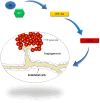Human papillomavirus and lung cancinogenesis: an overview
- PMID: 27357515
- PMCID: PMC11819305
- DOI: 10.1007/s00432-016-2197-1
Human papillomavirus and lung cancinogenesis: an overview
Abstract
Lung cancer is the most common cause of cancer deaths worldwide. Although tobacco smoking is considered to be the main risk factor and the most well-established risk factor for lung cancer, a number of patients who do not smoke have developed this disease. This number varies between 15 % to over one-half of lung cancer cases, and the deaths from lung cancer in non-smokers are increasing every year. There are many other agents that are thought to be etiological, including diesel exhaust exposure, metals, radiation, radon, hormonal factors, cooking oil, air pollution and infectious diseases, such as human papillomavirus (HPV). Studies in various parts of the world have detected HPV DNA at different rates in lung tumors. However, the role of HPV in lung cancer is still unclear. Thus, in this review, we investigated some molecular mechanisms of HPV protein activity in host cells, the entry of HPV into lung tissue and the possible route used by the virus to reach the lung cells.
Keywords: E6 HPV; E7 HPV; Human papillomavirus; Lung cancer; Molecular mechanism.
Conflict of interest statement
All the authors declare that he/she has no conflict of interest. Author B declares that he/she has no conflict of interest.
Figures





Similar articles
-
Prophylactic vaccination against human papillomaviruses to prevent cervical cancer and its precursors.Cochrane Database Syst Rev. 2018 May 9;5(5):CD009069. doi: 10.1002/14651858.CD009069.pub3. Cochrane Database Syst Rev. 2018. PMID: 29740819 Free PMC article.
-
A rapid and systematic review of the clinical effectiveness and cost-effectiveness of paclitaxel, docetaxel, gemcitabine and vinorelbine in non-small-cell lung cancer.Health Technol Assess. 2001;5(32):1-195. doi: 10.3310/hta5320. Health Technol Assess. 2001. PMID: 12065068
-
Human papillomavirus and lung cancer: an overview and a meta-analysis.J Cancer Res Clin Oncol. 2019 Aug;145(8):1919-1937. doi: 10.1007/s00432-019-02960-w. Epub 2019 Jun 24. J Cancer Res Clin Oncol. 2019. PMID: 31236668 Free PMC article. Review.
-
Interventions targeted at women to encourage the uptake of cervical screening.Cochrane Database Syst Rev. 2021 Sep 6;9(9):CD002834. doi: 10.1002/14651858.CD002834.pub3. Cochrane Database Syst Rev. 2021. PMID: 34694000 Free PMC article.
-
The Black Book of Psychotropic Dosing and Monitoring.Psychopharmacol Bull. 2024 Jul 8;54(3):8-59. Psychopharmacol Bull. 2024. PMID: 38993656 Free PMC article. Review.
Cited by
-
Individual and combined effect of TP53, MDM2, MDM4, MTHFR, CCR5, and CASP8 gene polymorphisms in lung cancer.Oncotarget. 2017 Nov 29;9(3):3214-3229. doi: 10.18632/oncotarget.22756. eCollection 2018 Jan 9. Oncotarget. 2017. PMID: 29423041 Free PMC article.
-
HPV-associated cancers: insights into the mechanistic scenario and latest updates.Med Oncol. 2023 Jun 26;40(8):212. doi: 10.1007/s12032-023-02085-8. Med Oncol. 2023. PMID: 37358816 Review.
-
Chemopreventive Role of Apigenin against the Synergistic Carcinogenesis of Human Papillomavirus and 4-(Methylnitrosamino)-1-(3-pyridyl)-1-butanone.Biomedicines. 2020 Nov 4;8(11):472. doi: 10.3390/biomedicines8110472. Biomedicines. 2020. PMID: 33158065 Free PMC article.
-
Overexpression of Human Papillomavirus Type 16 Oncoproteins Enhances Epithelial-Mesenchymal Transition via STAT3 Signaling Pathway in Non-Small Cell Lung Cancer Cells.Oncol Res. 2017 May 24;25(5):843-852. doi: 10.3727/096504016X14813880882288. Epub 2016 Dec 15. Oncol Res. 2017. PMID: 28508744 Free PMC article.
-
Presence and activity of HPV in primary lung cancer.J Cancer Res Clin Oncol. 2018 Dec;144(12):2367-2376. doi: 10.1007/s00432-018-2748-8. Epub 2018 Sep 17. J Cancer Res Clin Oncol. 2018. PMID: 30225539 Free PMC article.
References
-
- Amabile JC, Leuraud K, Vacquier B, Alain A, Dominique L (2009) Multifactorial study of the risk of lung cancer among French uranium miners: radon, smoking and silicosis. Health Phys 97(6):613–621 - PubMed
-
- Baba M, Castillo A, Koriyama C, Yanagi M, Matsumoto H, Natsugoe S, Shuyama KY, Khan N, Higashi M, Itoh T et al (2010) Human papillomavirus is frequently detected in gefitinib-responsive lung adenocarcinomas. Oncol Rep 23(4):1085–1092 - PubMed
Publication types
MeSH terms
LinkOut - more resources
Full Text Sources
Other Literature Sources
Medical

